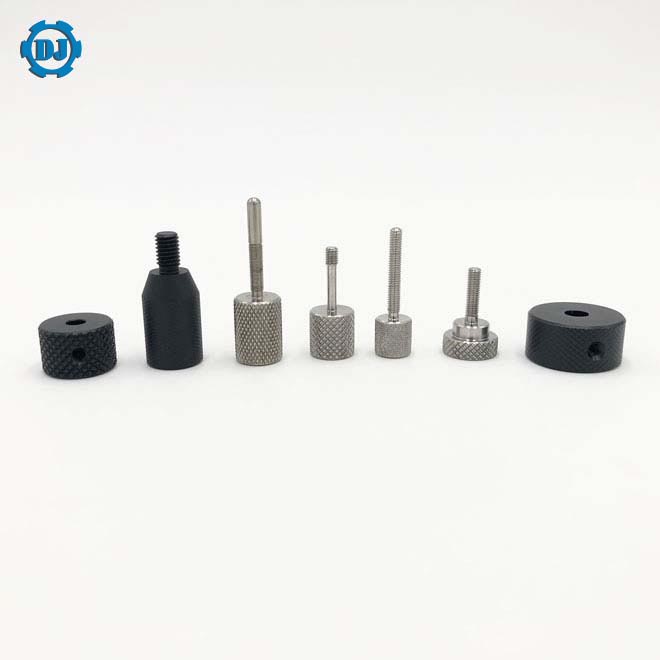3 Ways of Knurling on CNC Lathe | How to Complete the Knurling Process?
CNC knurling parts are widely applied due to the low cost and the ease of manufacturing, how to complete the CNC lathe knurling with knurling tool? Are there any new methods to create knurling on the parts? Here we introduce some important information about knurling. You can check out the Global Knurling Tool Market Report 2019 to learn more regarding the tooling.
Related Read: Screw Thread CNC Manufacturing Methods
What is Knurling?
Knurling is a modification process in CNC machining manufacturing, usually operated on a lathe, through making the pattern of straight, oblique, or crossed lines rolled into workpiece and the creating small ridges along it to provide a more rough surface of machining parts for better gripping, lifting and handling, such as knurling screws, nuts.
The knurling can be classified into straight knurling, cross knurling and spiral knurling based on the embossing or patterns. The knurling process is not a cutting or turning operation but forming techniques, it's simple and budget, generally conducted on metals, dajinprecision.com also provides quality POM knurled parts.
3 Ways of Knurling on CNC Lathe
To reduce the problems of the traditional knurling process, you can use the macro program to produce the CNC knurling parts.
1. Multi head thread turning lathe for cross knurling
The principle of this method is to regard the moire as a multi head thread with positive and negative interlacing. The traditional processing technology is to first generate programming other than knurling and φ 1.6 holes, then process the knurling, due to the high requirements of the position tolerance of CNC knurled parts, and the secondary clamping causes the long construction period and the high rejection rate. The new processing technology finished all the steps of the parts by clamping at one time, the processing accuracy is easy to be guaranteed.
Macro program examples:
Command format of CNC longitudinal cutting automatic lathe multi head thread:
G32ip - F - Q -; (IP -: end point, F -: pitch in long axis direction, q -: start angle of thread)
N4:
T0404M03S200; adjust tool 4; spindle forward
G0X5. Z-2.; to start of cycle
#1 = 0; set the starting point of thread angle
WHILE[#1LT360000]DO1; set cycle conditions
G0X2.85; enter coordinate starting point
G32Z5.5F12. Q#1; turning thread
X5.
G0z-2.; return to cycle start point
#1=[#1+24000]; set the starting point of the next thread angle
END1;
T0; cancel cutter compensation
M05;
T0404M04S200; left hand thread of the following turning
G0X5. Z-2.;
#1=0;
WHILE[#1LT360000]DO1;
G0X2.85;
G32Z5.5F12. Q#1;
X5.
G0Z-2.;
#1=[#1+24000];
END1;
T0;
M05;
Netted flower
2. Make use of the disordered thread for cross knurling
Disordered thread as multiple tapping is a common phenomenon when turning thread. Using this phenomenon, you can also process knurling. However, this method is more suitable for the knurled parts with fewer thread heads and small helix angle, and can improve the spindle speed, it also depends on the specific situation
3. Use the spindle locking function for the straight knurling
The machining principle of this method is that after the spindle is locked (the smaller the indexing value is, the better it is, which is conducive to accurate indexing), a groove is pulled out longitudinally on the surface of the machined part, and the continuous groove forms the straight knurling.
How to Complete the CNC Lathe Knurling Process?
Knurling process is utilizing the knurled tool to roll out the pattern on the surface of the workpiece, there are straight pattern and mesh pattern, the thickness of the pattern depends on the pitch.
1. The form of knurling and the shape of knurling pattern
The thickness of the knurled pattern shall be selected according to the diameter of the knurled surface of the workpiece, and the larger the diameter, the larger the module pattern.
2. Knurling processing
(1) Install the workpiece as firmly as possible.
- When installing the workpiece, the length of the protruding chuck should be the shortest.
- Long workpiece is supported by the tip.
- When turning the outer circle of knurled part, its diameter should be about 0.25mm smaller than the final size.
(2) Install the knurling tool.
- Observe whether the chips on the knurling tool are removed, use wire brush to clean if necessary.
- When installing the knurled cutter, the pivot pin shall be aligned.
- Clamp the tool firmly.
(3) Workpiece knurling.
- Select low cutting speed and large feed.
- Start the spindle of the machine tool and apply sufficient coolant to the knurled cutter.
- Move the knurled tooling to cut into the workpiece and apply pressure until a full diamond pattern is formed.
- Carry out the longitudinal feed after the transverse feed, until the required knurled length is obtained.
- Move the knurled cutter to leave the workpiece quickly.
(4) Chamfer. On the surface of the workpiece, the burr is removed by cutting a 45 ° chamfer to the bottom of the knurled groove.
- Adjust the knurling tool visually to deflect it by a small angle.
- Clamp the tool firmly.

